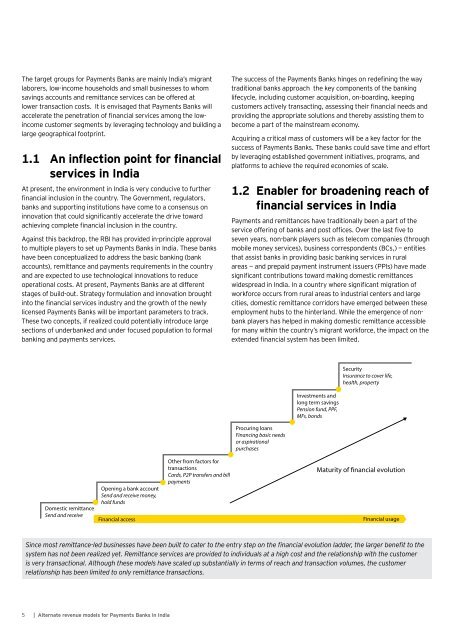Alternate revenue models for Payments Banks in India
29oMCDq
29oMCDq
Create successful ePaper yourself
Turn your PDF publications into a flip-book with our unique Google optimized e-Paper software.
The target groups <strong>for</strong> <strong>Payments</strong> <strong>Banks</strong> are ma<strong>in</strong>ly <strong>India</strong>’s migrant<br />
laborers, low-<strong>in</strong>come households and small bus<strong>in</strong>esses to whom<br />
sav<strong>in</strong>gs accounts and remittance services can be offered at<br />
lower transaction costs. It is envisaged that <strong>Payments</strong> <strong>Banks</strong> will<br />
accelerate the penetration of f<strong>in</strong>ancial services among the low<strong>in</strong>come<br />
customer segments by leverag<strong>in</strong>g technology and build<strong>in</strong>g a<br />
large geographical footpr<strong>in</strong>t.<br />
1.1 An <strong>in</strong>flection po<strong>in</strong>t <strong>for</strong> f<strong>in</strong>ancial<br />
services <strong>in</strong> <strong>India</strong><br />
At present, the environment <strong>in</strong> <strong>India</strong> is very conducive to further<br />
f<strong>in</strong>ancial <strong>in</strong>clusion <strong>in</strong> the country. The Government, regulators,<br />
banks and support<strong>in</strong>g <strong>in</strong>stitutions have come to a consensus on<br />
<strong>in</strong>novation that could significantly accelerate the drive toward<br />
achiev<strong>in</strong>g complete f<strong>in</strong>ancial <strong>in</strong>clusion <strong>in</strong> the country.<br />
Aga<strong>in</strong>st this backdrop, the RBI has provided <strong>in</strong>-pr<strong>in</strong>ciple approval<br />
to multiple players to set up <strong>Payments</strong> <strong>Banks</strong> <strong>in</strong> <strong>India</strong>. These banks<br />
have been conceptualized to address the basic bank<strong>in</strong>g (bank<br />
accounts), remittance and payments requirements <strong>in</strong> the country<br />
and are expected to use technological <strong>in</strong>novations to reduce<br />
operational costs. At present, <strong>Payments</strong> <strong>Banks</strong> are at different<br />
stages of build-out. Strategy <strong>for</strong>mulation and <strong>in</strong>novation brought<br />
<strong>in</strong>to the f<strong>in</strong>ancial services <strong>in</strong>dustry and the growth of the newly<br />
licensed <strong>Payments</strong> <strong>Banks</strong> will be important parameters to track.<br />
These two concepts, if realized could potentially <strong>in</strong>troduce large<br />
sections of underbanked and under focused population to <strong>for</strong>mal<br />
bank<strong>in</strong>g and payments services.<br />
The success of the <strong>Payments</strong> <strong>Banks</strong> h<strong>in</strong>ges on redef<strong>in</strong><strong>in</strong>g the way<br />
traditional banks approach the key components of the bank<strong>in</strong>g<br />
lifecycle, <strong>in</strong>clud<strong>in</strong>g customer acquisition, on-board<strong>in</strong>g, keep<strong>in</strong>g<br />
customers actively transact<strong>in</strong>g, assess<strong>in</strong>g their f<strong>in</strong>ancial needs and<br />
provid<strong>in</strong>g the appropriate solutions and thereby assist<strong>in</strong>g them to<br />
become a part of the ma<strong>in</strong>stream economy.<br />
Acquir<strong>in</strong>g a critical mass of customers will be a key factor <strong>for</strong> the<br />
success of <strong>Payments</strong> <strong>Banks</strong>. These banks could save time and ef<strong>for</strong>t<br />
by leverag<strong>in</strong>g established government <strong>in</strong>itiatives, programs, and<br />
plat<strong>for</strong>ms to achieve the required economies of scale.<br />
1.2 Enabler <strong>for</strong> broaden<strong>in</strong>g reach of<br />
f<strong>in</strong>ancial services <strong>in</strong> <strong>India</strong><br />
<strong>Payments</strong> and remittances have traditionally been a part of the<br />
service offer<strong>in</strong>g of banks and post offices. Over the last five to<br />
seven years, non-bank players such as telecom companies (through<br />
mobile money services), bus<strong>in</strong>ess correspondents (BCs,) — entities<br />
that assist banks <strong>in</strong> provid<strong>in</strong>g basic bank<strong>in</strong>g services <strong>in</strong> rural<br />
areas — and prepaid payment <strong>in</strong>strument issuers (PPIs) have made<br />
significant contributions toward mak<strong>in</strong>g domestic remittances<br />
widespread <strong>in</strong> <strong>India</strong>. In a country where significant migration of<br />
work<strong>for</strong>ce occurs from rural areas to <strong>in</strong>dustrial centers and large<br />
cities, domestic remittance corridors have emerged between these<br />
employment hubs to the h<strong>in</strong>terland. While the emergence of nonbank<br />
players has helped <strong>in</strong> mak<strong>in</strong>g domestic remittance accessible<br />
<strong>for</strong> many with<strong>in</strong> the country’s migrant work<strong>for</strong>ce, the impact on the<br />
extended f<strong>in</strong>ancial system has been limited.<br />
Security<br />
Insurance to cover life,<br />
health, property<br />
Investments and<br />
long term sav<strong>in</strong>gs<br />
Pension fund, PPF,<br />
MFs, bonds<br />
Procur<strong>in</strong>g loans<br />
F<strong>in</strong>anc<strong>in</strong>g basic needs<br />
or aspirational<br />
purchases<br />
Domestic remittance<br />
Send and receive<br />
Open<strong>in</strong>g a bank account<br />
Send and receive money,<br />
hold funds<br />
F<strong>in</strong>ancial access<br />
Other from factors <strong>for</strong><br />
transactions<br />
Cards, P2P transfers and bill<br />
payments<br />
Maturity of f<strong>in</strong>ancial evolution<br />
F<strong>in</strong>ancial usage<br />
S<strong>in</strong>ce most remittance-led bus<strong>in</strong>esses have been built to cater to the entry step on the f<strong>in</strong>ancial evolution ladder, the larger benefit to the<br />
system has not been realized yet. Remittance services are provided to <strong>in</strong>dividuals at a high cost and the relationship with the customer<br />
is very transactional. Although these <strong>models</strong> have scaled up substantially <strong>in</strong> terms of reach and transaction volumes, the customer<br />
relationship has been limited to only remittance transactions.<br />
5 | <strong>Alternate</strong> <strong>revenue</strong> <strong>models</strong> <strong>for</strong> <strong>Payments</strong> <strong>Banks</strong> <strong>in</strong> <strong>India</strong>


